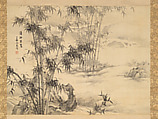“Profound Refinement, Escaping the Dust of the World”
Noguchi Shōhin 野口小蘋 Japanese
Not on view
This impressively scaled and boldly brushed ink painting of bamboo stalks and rocks beside a stream is one of the largest known hanging scrolls by the woman artist Noguchi Shōhin. She and Okuhara Seiko (1837–1913) were the most famous female painters in the Meiji era. Beside her signature, the painter inscribed in dynamic calligraphy the painting’s title “Profound Refinement, Escaping the Dust of the World” (Shōsa shitsujin 瀟洒出塵) recalling a pervasive theme of Chinese-infused Literati painting in Japan through the early modern times. According to Confucius, the rustling sound of wind in a bamboo grove purified the mind. Here, a stream flowing through the grove complements this idea with an image that suggests the washing away of worldly desires. The phrase “escaping the dust of the world” (shitsujin 出塵) also refers to a monk or nun who has renounced secular life, suggesting that this splendid composition may have been commissioned to commemorate someone taking the tonsure. The scale of the painting on silk and its sumptuous gold silk brocade mounting enhances the possibility that it might have been created for a temple setting, but this requires further research.
The composition artfully conveys a sense of recession and the veiling effects of mist with the darkly inked bamboo in the foreground contrasting with the pale washed details in the background. To achieve this effect, some of the most prominent bamboo stalks and rocks were brushed first, with the landscape painted around them in pale gray ink tones. A final layer of bamboo in darker tones and the darkest moss dots and stray twigs were added last to create the sense of spatial depth and to provide accents and balance.
From an early age, despite the difficulty of women from setting out on their own in Edo society, Shōhin demonstrated her perseverance and talent. Born in Osaka to a family of physicians with the given name Chikako, after her father died she became the head of the household and began to support her mother from age sixteen. Shōhin had already begun to paint seriously even as a child and went on to study bird-and-flower and landscape painting under the Kyoto-based Literati artist Hine Taizan (1813–1869). She painted for the Meiji Emperor and had close connections with imperial family circles and was appointed Official Artist of the Imperial Household. She was photographed with Tomioka Tessai when they both painted for the Emperor, becoming quite a celebrity in her day. She exhibited a prizewinning landscape in Chicago’s World’s Columbian Exposition of 1893. Like many other female painters, her work has been sometimes stereotyped as very “delicate,” but the massive size and power of the brushwork of this painting, done when she was in her early sixties, shows how wrong that assessment can be.
This image cannot be enlarged, viewed at full screen, or downloaded.
This artwork is meant to be viewed from right to left. Scroll left to view more.



